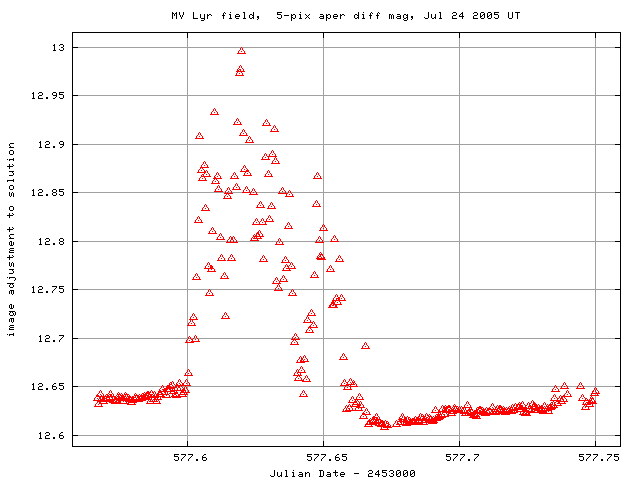
On the night of Jul 25/26, 2005 EDT, I used the RIT Observatory's 12-inch Meade telescope and SBIG ST8 CCD camera to monitor the cataclysmic variable star MV Lyr. This star is currently being monitored by the Center for Backyard Astrophysics. You can read Lew Cook's description of the system for very nice background information and an analysis of its behavior a few years ago.
The plan:
Notes from the night
You can see the effect of clouds in these graphs of "adjustment:" the amount in magnitudes by which each image's zeropoint must be shifted to meet the ensemble average. On a clear night, the adjustments slowly vary by a few hundredths of a magnitude ... but not on this night! Adjustments added to the early dataset:

Adjustments added to the later dataset:

In each case, banks of clouds causing up to 0.40 mag of extinction moved over the field. Sigh.
Here's a chart of the field of MV Lry taken in an earlier run. The field is about 20 arcminutes wide. Click on the picture for a larger version.
The star marked "A" in the chart above is USNOB1.0 1367-0288714. It was measured by Henden and Honeycutt, PASP 107, 324 (1995), who found V = 12.518. Based on that value, and assuming that these unfiltered images have approximately a V-band passband, the variable MV Lyr was around V = 12.7 on this night.
The star marked "B" on the chart above is GSC 0313201412. Lew Cook has found that this star may be variable with a small amplitude:
The chart above shows a circle around the star NSV 11753 , which is listed as a Cepheid with range from V=13.5 to V=14.4.
I measured the instrumental magnitude of each star with aperture photometry, using a radius of 5 pixels = 9.3 arcseconds (a little larger than previous runs, due to some troubles with the guider), and sky defined by an annulus around each star. Following the procedures outlined by Kent Honeycutt's article on inhomogeneous ensemble photometry, I used all stars available in each image to define a reference frame, and measured each star against this frame.
Around 2:00 AM local time, I discovered that some cables running from the camera to the computer had caught on the mount; as a result, the camera started to unscrew itself (yuck!) and the field rotated. I had to rotate the camera by 180 degrees and re-attach the cables to prevent this from happening again. Because I didn't rotate the camera by exactly 180 degrees, there was a bit of residual rotation between the images taken before and after this interruption. My ensemble code can't handle the rotation, so I had to break the night up into two datasets, and reduce each one independently.
Below is a graph of the scatter in differential magnitude versus magnitude, for each of the two datasets.
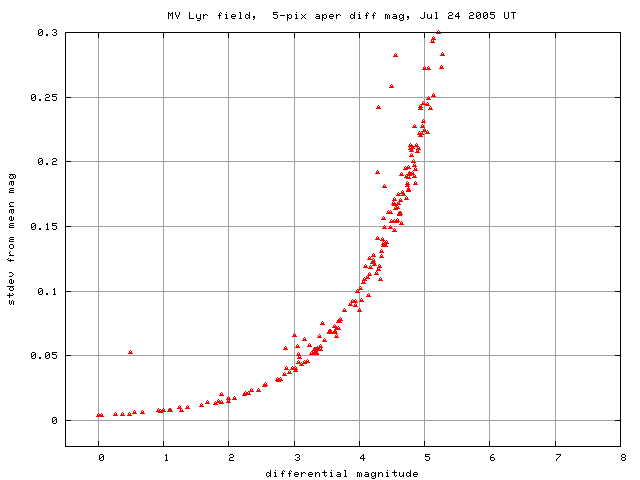
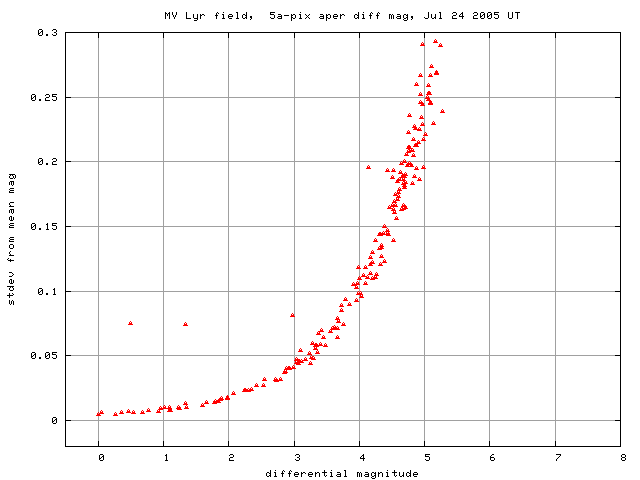
MV Lyr is the star near differential mag 0.5, with an elevated scatter. The other outliers in the second dataset are
Light curves for selected stars in the field are shown below. MV Lyr, shown by light green crosses near the top, is clearly variable. The dark green points around differential magnitude 0.6 are NSV 11753, which showed no significant variation during the night. The black points around differential magnitude 3 are measurements of V0449 Lyr (the single high point is a cosmic ray, and does not cause the large scatter in the second dataset). See Lew Cook's report on photometry of V0449 Lyrae.
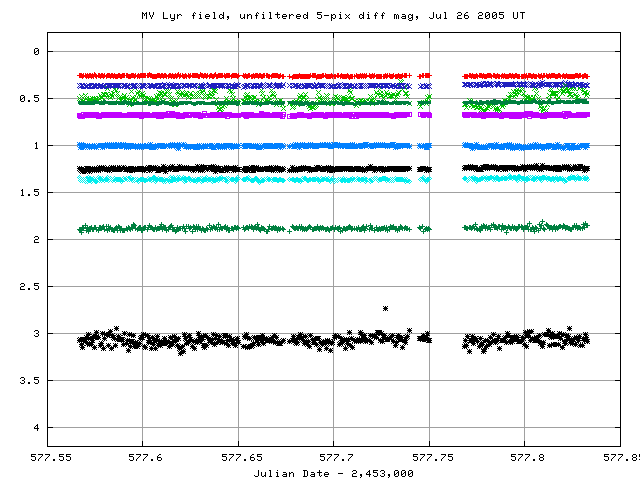
Here's a closeup of the variation in MV Lyr itself:
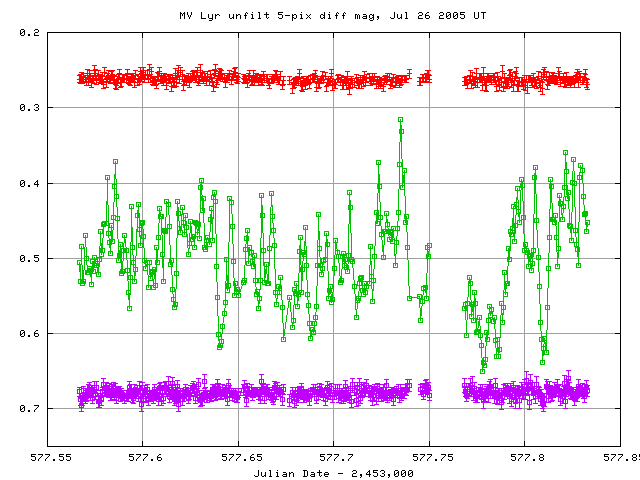
The star shows a jagged light curve with sharp features. Some of the changes in brightness are so quick that the magnitude jumps from one image to the next; it might be a good idea to decrease the exposure length.
I've made a table of the measurements themselves, with three different flavors of time. The differential unfiltered magnitudes from the ensemble solution has been shifted so that star "A" in my chart, has value 12.518, matching its V-band magnitude as determined by Henden and Honeycutt.
Here's the start of the table:
# Measurements of MV Lyr made at RIT Obs, Jul 26, 2005 UT, # made by Michael Richmond in mediocre conditions. # All data taken with 12-inch LX-200 + no filter + SBIG ST-8 CCD # no focal reducer, so at native f/10 # Each exposure 30 seconds long; tabulated times are midexposure # and accurate only to +/- 1 second. # 'mag' is a differential magnitude based on ensemble photometry # which has been shifted so USNOB1.0 1367-0288714 has mag=12.518 # (the V mag from Henden and Honeycutt, PASP 107, 324, 1995). # # UT day JD-2,450,000 HJD-2,450,000 mag uncert Jul26.06668 3577.56668 3577.56909 12.761 0.034 Jul26.06722 3577.56722 3577.56963 12.787 0.018
Last modified 7/26/2005 by MWR.